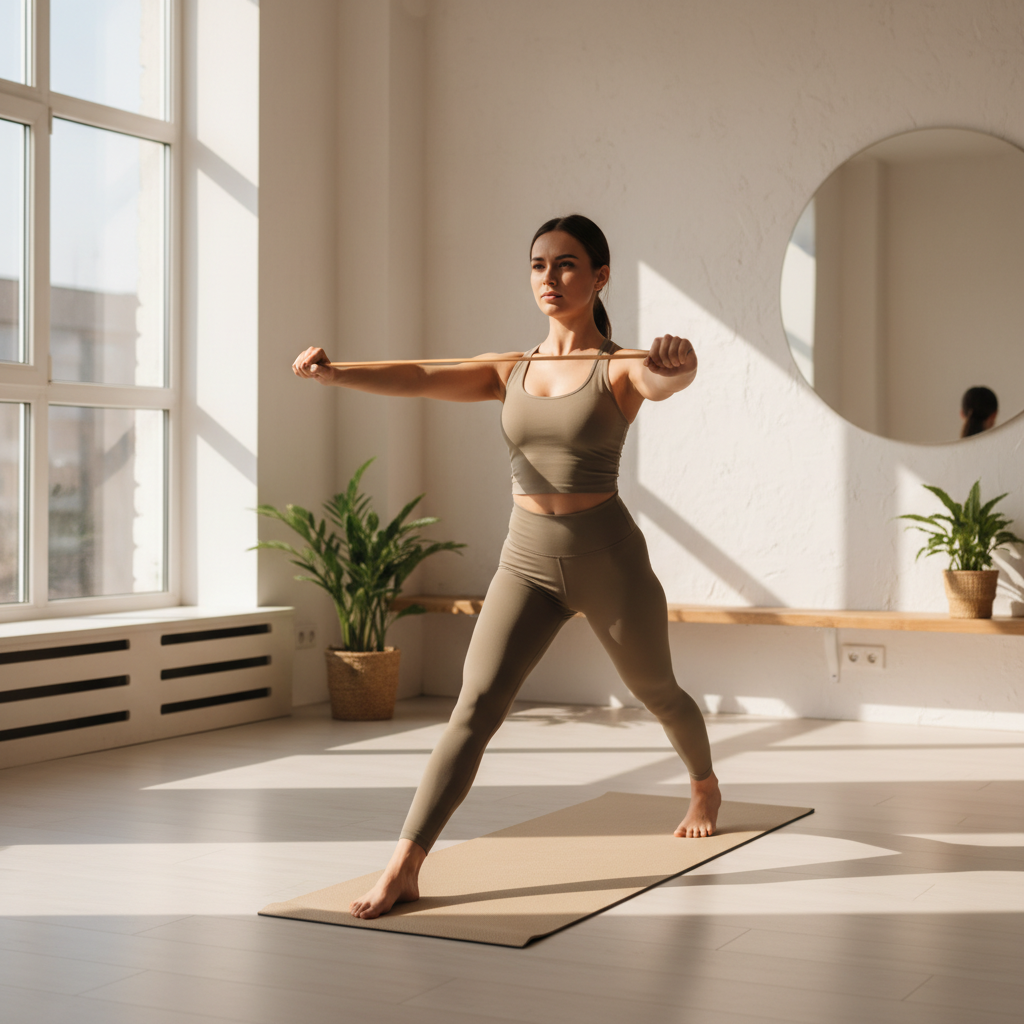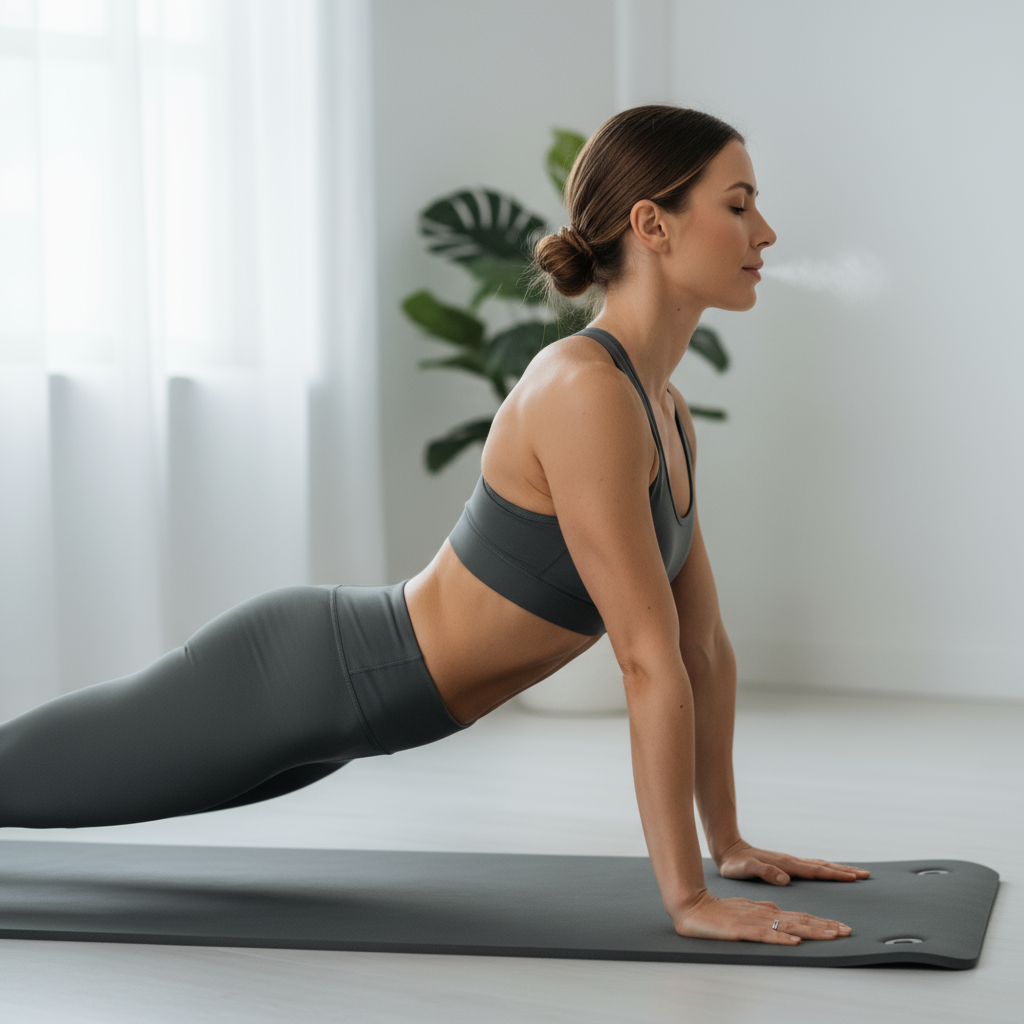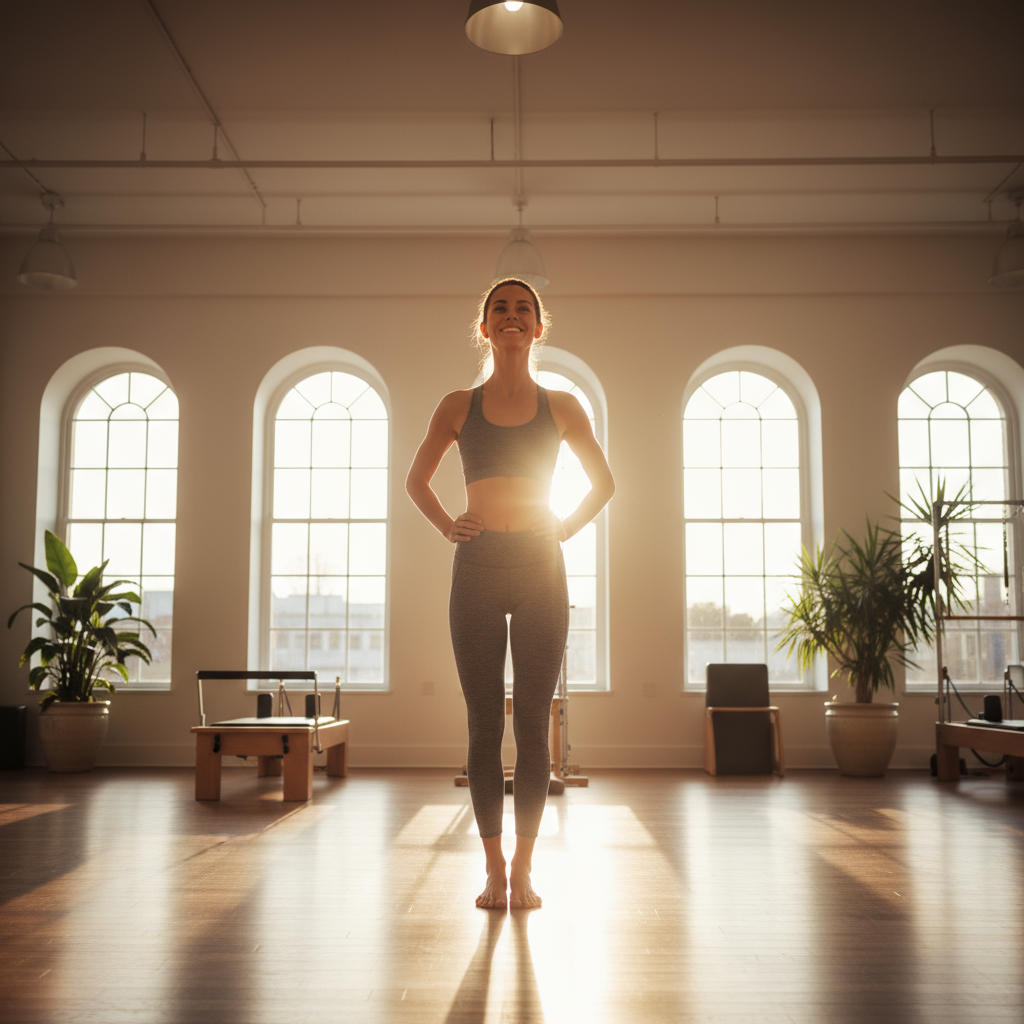
Table of Contents
Introduction
Picture this: you’re standing at the edge of a Pilates studio, mat in hand, feeling equal parts excited and nervous. Sound familiar? Whether you want to strengthen your core, fix your posture, or just try something new, starting Pilates can feel like stepping into uncharted territory. But here’s the good news—this guide is designed specifically for people like you who are ready to give Pilates a shot but aren’t quite sure where to start.
Let’s be honest—Pilates has become pretty popular lately, and for good reason. It’s not just about getting a workout; it’s about connecting your mind and body in ways that other exercises simply can’t match. What draws most beginners in? The promise of building serious core strength, gaining flexibility, and actually fixing that slouchy posture we all developed from too many hours at our desks. And here’s what’s really encouraging: you don’t need months to see results. Many people notice real improvements in muscle tone and how they feel overall after just a few weeks of sticking with it. If you’re wondering about the bigger picture of starting any fitness routine, checking out how to start a fitness routine can give you a solid foundation before you jump into Pilates-specific moves.
Now, before you roll out that mat, let’s talk prep work. (Trust me, a little planning goes a long way.) You’ll want a decent mat—nothing fancy, just something that won’t slip around when you’re trying to hold a plank. Comfortable clothes that let you move freely are a must. Nobody wants to worry about their shirt riding up during a roll-up! Creating a calm, clutter-free space makes a huge difference too. It helps you focus and makes it easier to stick with your practice. Thinking about adding some props down the road? Resistance bands or a Pilates ring can really take your workouts up a notch. They’re not essential when you’re starting out, but they do help you nail proper technique and get better results. If you’re curious about how Pilates fits into functional fitness, the guidance in functional fitness workouts is really helpful—especially since Pilates focuses so much on full-body coordination and strength.
Here’s something cool about Pilates: it plays really well with other aspects of wellness. You’re not just working out; you’re creating a foundation for overall health. The breathing techniques and mindful movement you’ll learn can enhance everything else you do. And if you’re looking to build muscle or change your body composition, understanding things like nutrition for weight gain can amplify your Pilates results big time. It all works together—the movement, the nutrition, the recovery. That’s what makes this approach so sustainable and effective in the long run.
What You’ll Learn in This Guide
This guide covers everything you need to safely and confidently start Pilates as a beginner. We’ll walk you through the foundational principles, essential preparations, and the simplest yet most effective exercises. Here’s what to expect:
- Understanding Pilates Basics: Learn about Pilates philosophy, key movements, and how this practice differs from other workouts. We explain why Pilates emphasizes core strength and mindful movement, helping you connect with your body in new ways.
- Essential Equipment and Space Setup: Discover what gear you’ll need, including mats and optional props, and how to create a calming environment conducive to focus and progress in your practice.
- Beginner-friendly Pilates Exercises: Get step-by-step instructions on foundational moves such as the Hundred, Single Leg Circles, and Roll-Ups. These exercises build strength, flexibility, and improve posture gradually and safely.
- Tips for Consistent Practice: Learn how to maintain proper breathing, alignment, and rhythm. We’ll also share strategies to stay motivated and integrate Pilates effectively into your weekly fitness routine.
Throughout this guide, we’ll dig deeper into each of these areas with practical tips and expert advice to help you get the most from your Pilates journey. You might also want to explore how to build cardio endurance to round out your fitness routine—Pilates and cardio make a pretty amazing combination for balanced, sustainable results. With the right approach and some patience with yourself, Pilates can genuinely transform how you move and feel. We’re talking improved strength, better flexibility, and that confident posture that makes you stand a little taller.
By the time you finish reading this guide, you’ll have everything you need to start your Pilates practice with genuine confidence. You’ll know the essential exercises, understand proper form, and have the right mindset to keep progressing (even on days when motivation is low). Whether you want to move better, feel less tense, or just shake up your exercise routine, Pilates offers a welcoming path that actually works for beginners.
Ready to get started? Your future self—with better posture, stronger core, and that amazing mind-body connection—is going to thank you for taking this first step. Let’s make Pilates a part of your routine and discover what this practice can do for you.

So you’re ready to take your Pilates journey to the next level? Perfect. Pilates really is one of those rare workouts that hits all the right notes—you’ll get stronger, more flexible, and notice your posture improving without feeling like you’ve been hit by a truck. What I love most about it is how it makes you really pay attention to your body. Every movement has purpose.
Basic Pilates Exercises for Beginners
Look, I get it. Walking into your first Pilates class (or rolling out your mat at home) can feel a bit intimidating. There are so many movements, and everyone else seems to know exactly what they’re doing. But here’s the thing—those “experts” were beginners once too. The secret? Start with the fundamentals and nail those first.
Think of it like learning to cook. You don’t start with beef wellington—you master scrambled eggs first. Same principle applies here. The Hundred, Single Leg Circles, and Roll-Up might sound fancy, but they’re your scrambled eggs. These core movements will teach your body how to move with control and precision. And if you really want to supercharge your core work, check out this guide on core stability—it pairs beautifully with what you’ll learn in Pilates.
Once you get comfortable with these basics, you’ll start noticing changes. Your core gets stronger (obviously), but your whole body starts working better together. It’s like upgrading your body’s operating system. Want to keep that momentum going? These fitness challenges for beginners can add some variety to your routine and keep things interesting.
Key Aspects of Basic Pilates Exercises
Here’s what you need to know to get the most out of each session:
- Core Strengthening Movements: This isn’t about getting six-pack abs (though that’s a nice bonus). We’re talking about building the deep muscles that keep your spine happy and your balance on point. The Hundred is perfect for this—it teaches you to breathe while your core is working hard, which is trickier than it sounds.
- Flexibility and Mobility Exercises: Your joints want to move, and Pilates gives them permission to do just that. These gentle movements help you move better in everyday life. Think about it—when’s the last time you could touch your toes without wincing?
- Posture and Alignment Focus: Remember when your mom told you to stand up straight? She was onto something. Pilates teaches your body what good alignment actually feels like. Your shoulders, spine, and pelvis learn to work as a team instead of fighting each other.
- Breath Control: This might be the most underrated part of Pilates. When you sync your breathing with movement, something magical happens. Your muscles get more oxygen, you feel calmer, and suddenly those challenging exercises become more manageable.
The beauty of Pilates is that it doesn’t rush you. Your body gets stronger gradually, which means you’re less likely to get hurt and more likely to stick with it. And speaking of sticking with it, these posture correction exercises work amazingly well alongside your Pilates practice if you’re dealing with the “desk hunched” look.
Tips for Effective Pilates Practice
Want to know the difference between people who love Pilates and those who give up after a few sessions? It’s not natural ability or flexibility. It’s knowing how to practice smart. The good news is that smart practice isn’t complicated—it just requires a little know-how and consistency.
First things first: form beats everything else. I’d rather see you do five perfect movements than twenty sloppy ones. Your body learns patterns, and you want to teach it good ones from the start. When you focus on alignment, you’re not just preventing injury—you’re making sure the right muscles are doing the work. And if motivation is your struggle (because let’s be honest, it happens to all of us), these tips to stay motivated to exercise can be total game-changers.
Another thing? Don’t try to be perfect right out of the gate. Pilates has this way of humbling even the fittest people. That’s actually a good thing—it means you’re challenging your body in new ways. For extra support with alignment and posture awareness, definitely check out these posture improvement techniques. They complement Pilates perfectly.
Key Aspects of Effective Pilates Practice
These strategies will take your practice from good to great:
- Breathing Techniques: Your breath is like the conductor of an orchestra—it keeps everything in sync. When you breathe properly during exercises, your muscles work more efficiently and you’ll feel less tension. Plus, it helps you stay calm when things get challenging.
- Maintaining Proper Alignment: Think of your body as a well-tuned car. Everything needs to be aligned for optimal performance. Use a mirror if you have one, or better yet, get feedback from an instructor. Your future self will thank you for building good habits now.
- Building Consistency: Here’s the truth—three times a week beats one marathon session every two weeks. Your body responds to regular, consistent work. Even 20 minutes a few times a week will make a noticeable difference.
- Mindful Concentration: This isn’t just about going through the motions. When you really focus on what you’re doing, each movement becomes more effective. It’s like the difference between mindlessly scrolling your phone and actually reading a good book.

Starting your Pilates journey? You’re in for something special. This practice isn’t just about getting stronger (though you definitely will)—it’s about building that rock-solid foundation your body craves. Think of exercises like The Hundred, Roll-Up, and Single Leg Circles as your new best friends. They’ll teach your body how to move with purpose and help you discover muscles you forgot you had. And here’s the best part: you don’t need a fancy studio to get started. A good non-slip mat, clothes you can move in, and enough space to stretch out your arms? That’s your ticket to better posture and core strength.
But Pilates goes deeper than just the physical stuff. There’s something almost meditative about the way breathing and movement work together—like your mind and body finally decide to have a proper conversation. You’ll notice it during your first few sessions: that moment when everything clicks and you feel completely present. It’s not just about building muscle; it’s about building awareness. And trust me, once you start seeing those gradual improvements in how you stand, sit, and move through your day, you’ll understand why people get hooked on this practice.
Ready to take things up a notch? Here’s where it gets exciting. You can layer in some targeted challenges that’ll keep your routine fresh and your progress measurable. Posture work pairs beautifully with Pilates—think of it as reinforcing what you’re already learning about alignment. And let’s be real: staying motivated can be tough sometimes. That’s normal! The key is mixing things up and celebrating those small wins. Adding some cardio work into the mix? Even better. Your heart will thank you, and it’ll make your Pilates sessions feel that much stronger.
Want to dive deeper? Check out our comprehensive fitness challenges for beginners to keep things interesting and goal-oriented. If posture is your main concern (and let’s face it, most of us could use help there), our guide on the best exercises for posture correction is exactly what you need. Struggling with motivation? We’ve all been there. Our tips on how to stay motivated to exercise will help you push through those “I don’t feel like it” days. And if you’re ready to boost your overall fitness game, our advice on how to build cardio endurance will round out your routine perfectly.
Here’s the thing about Pilates: consistency beats perfection every single time. Show up regularly, listen to your body, and trust the process. Those little improvements add up faster than you’d expect. Want to really nail down your core work? Our detailed guide on how to improve core stability will take your foundation to the next level. Remember, every session is a step forward—toward better posture, more flexibility, and a body that feels genuinely strong. Be patient with yourself. Your future self will absolutely thank you for starting this journey.
Frequently Asked Questions
-
What are the best Pilates exercises for beginners?
- Basic core strengthening and flexibility exercises such as The Hundred and Roll-Up are highly effective starting points.
-
Do I need any special equipment to start Pilates?
- A mat and comfortable clothing are usually sufficient for beginners starting Pilates practice.
-
How often should beginners practice Pilates?
- Practicing Pilates 2-3 times per week helps build consistency and allows for steady progression.
-
Can Pilates help with posture?
- Yes, Pilates focuses on alignment and body awareness, which improve posture over time.
-
When should I see a professional Pilates instructor?
- If you experience pain or have difficulty maintaining proper form, seeking professional guidance is recommended.
